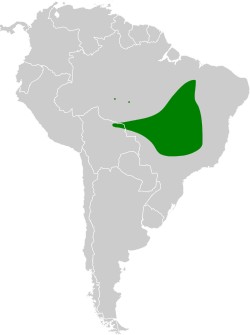Distribution and habitat
The chapada flycatcher is found in central and southwestern Brazil from Maranhão south and west through Tocantins, Mato Grosso, Goiás, Minas Gerais, and Mato Grosso do Sul into extreme eastern Santa Cruz Department in Bolivia. It primarily inhabits typical cerrado and also the more specialized campo cerrado and campo sujo within it. All are characterized by shrubby areas with scattered trees within grasslands; the trees are typically 2 to 5 m (7 to 16 ft) tall. In elevation it mostly occurs between 250 and 750 m (800 and 2,500 ft) but possibly is found as high as 1,200 m (3,900 ft). [4] [12]
Behavior
Movement
The chapada flycatcher is a year-round resident throughout its range. [4]
Feeding
The chapada flycatcher feeds on arthropods and small fruits. It usually forages from the middle of trees to their crowns and only rarely in shrubs or on the ground. It takes food mostly by gleaning from leaves and branches while perched or briefly hovering, and less often makes sallies to take insects in flight. [4]
Breeding
The chapada flycatcher's breeding season has not been defined but appears to end in October. Males make a display during which they flick their wings and fan their tail. This display was part of the evidence for its recognition as a species, because the suiriri flycatcher does not display. Nothing else is known about the species's breeding biology. [4] [5]
 | Songs and calls
|
Vocalization
The chapada flycatcher's vocalizations are a significant reason for its recognition as a species. They are differert from those of the suiriri flycatcher, and both species ignore the vocalizations of the other. Pairs give different songs during duets. Males make "a loud series of paired couplets, a repeated twangy 'where where, whooz it' " and females "a loud bubbly rattle of variable length and typically preceded by one or two 'whur' notes". Females also make "zhuwheep" or "zhuwheep-oo" contact calls. [4] [5]
This page is based on this
Wikipedia article Text is available under the
CC BY-SA 4.0 license; additional terms may apply.
Images, videos and audio are available under their respective licenses.




